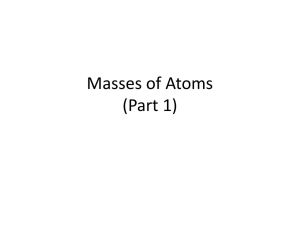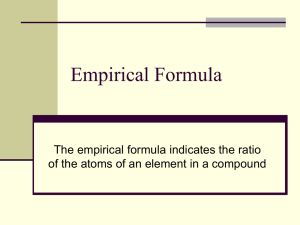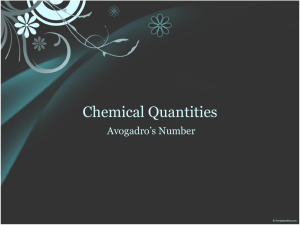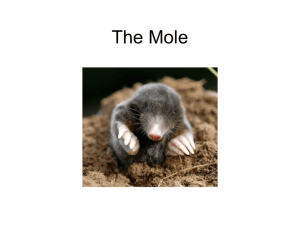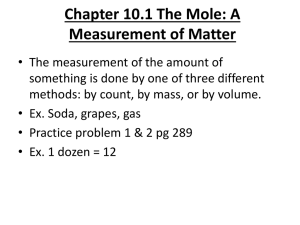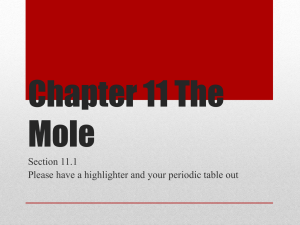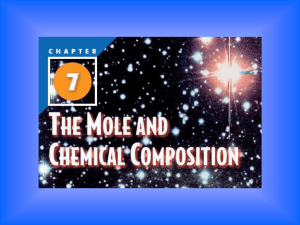Example - GST Boces
advertisement
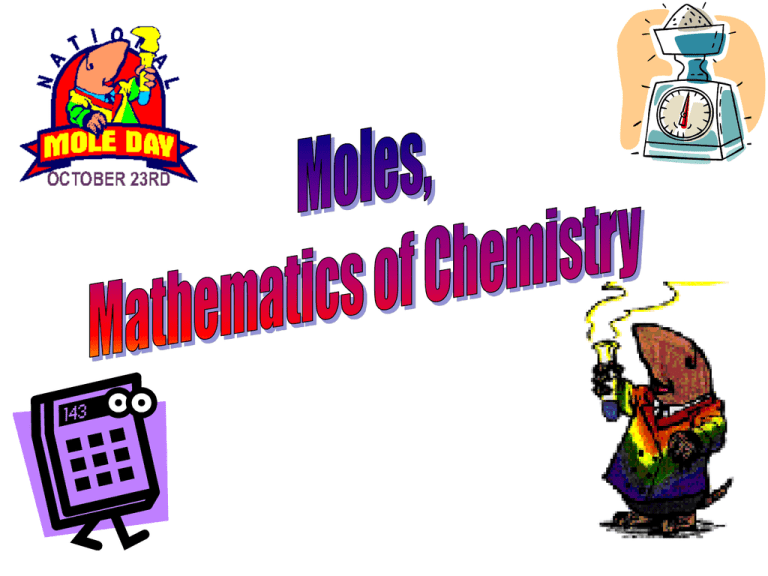
• Each element has been assigned a unique one-, two-, or three-letter symbol for its identification • The first letter of a symbol is always capitalized • Only recently discovered elements that don’t yet have permanent names are given three-letter symbols • Uncombined elements are written as monatomic (without a subscript) – Examples: Fe, C, Al • Diatomic elements – 2 of the same atoms (HOFBrINCl’s) – Examples: H2, O2 • The atomic mass of an element is given in atomic mass units (amu) • Found on the periodic table • The mass of 1 mole of an element is equal to its atomic mass (periodic table) in grams • The sum of the atomic masses of its atoms Example: CO2 = Mass Examples • Find the atomic or formula mass of the following substances: (To the nearest tenth) 1. 2. 3. 4. 5. 6. C Br Cl2 H2O Ca3PO4 Ca(OH)2 • The mass of 1 mole of the substance • Measured in grams Example: 1.0 mole of CO2 = 44g • Use the gram formula mass to convert between moles and mass Examples: 1. 1.5 moles of CO2 = _______ g 2. 24 g of C = _______ moles 3. 3.0 moles of Br = _______ g 4. 5.0 g of Al = _______ moles • If you have an ideal gas at standard temperature and pressure (STP) – 0oC and 1atm 1 mole = 22.4 L Mole – Volume Examples 1. 1.5 moles of CO2 (g) = _______ L 2. 38 L of Ne(g) = _______ moles 3. 3.0 moles of O2(g) = _______ L 4. 11 L of N2(g) = _______ moles • 1 dozen = 12 • 1 mole = 6.02 x 1023 (Avagadro’s Number) • How big is a mole? – 602,000,000,000,000,000,000,000 – A mole of marbles would spread over the surface of the earth, and produce a layer about 50 miles thick – A mole of sand, spread over the United States, would produce a layer 3 inches deep – A mole of dollars could not be spent at the rate of a billion dollars a day over a trillion years • He stated that equal volumes of all gases at the same temperature and pressure contain the same number of molecules (Acogadro’s Principle) • Later his work led to the realization Amedeo Avogadro that a molecular mass in grams (mole) of any substance contains the same number of molecules (6.02 x 1023) 1 mole of atoms = 6.02 x 1023 atoms 1 mole of particles = 6.02 x 1023 particles 1 mole of molecules = 6.02 x 1023 molecules 1 mole of compounds = 6.02 x 1023 compounds Mole – Number Examples 1. 4.00 moles of NaCl = _______ molecules 2. 0.50 mole of MgBr2 = _______ molecules 3. 3.01 x 1023 NaCl molecules = _______ moles 4. 6.02 x 1021 Zn atoms = _______ moles Empirical Formulas • Represents the simplest integer ratio in which the atoms combine to form a compound (the reduced form) • All ionic formulas are written as empirical formulas Molecular Formulas • The actual numbers of the atoms in a molecule • May be a multiple of the empirical formula Examples: • What are the empirical formulas of the following molecules? a. H2O2 b. C6H12O6 c. CCl4 Percent Composition • Composition in terms of the percentage of each component present Example: H2SO4 – Step 1: Calculate the formula mass of H2SO4 – Step 2: Find the percent mass of each element Percent Mass Example • Calculate the percent composition of oxygen in CO2 Water of Hydration • Percentage of water in the crystal – Hydrate – a compound that contains water – Anyhdrous – hydrate without the water Water of Hydration Example • Find the water of hydration in CuSO45H20 • Step 1 - Find the formula mass • Step 2 - Percentage of water Water of Hydration Example • Calculate the water of hydration in Na2CO310H2O Determining Mass Ratios from Formulas • Example: Find the mass ratio for a compound with the empirical formula CH2. Determining the Molecular Formula from the mass and the empirical formula A compound has a molecular mass of 180amu and an empirical formula of CH2O. What is its molecular formula? • Step 1: Determine the molecular mass of the empirical formula • Step 2: Divide the molecular mass of the compound by the mass of the empirical formula. • Step 3: Multiply the subscripts in the empirical formula by your answer to step 2 Determining the empirical formula from percent composition What is the empirical formula of a compound that consists of 58.80% barium, 13.75% sulfur, and 27.45% oxygen by mass? • Step 1: Assume that the mass of the sample is 100g • Step 2: Convert the masses into moles • Step 3: Find the smallest whole numbers ratio (divide each number from step 2 by the smallest one) Chemical Reactions • Reactant – Substance that enters into a reaction, written to the left of the arrow, starting material • Product – substance that is produced by the reaction, written to the right of the arrow, end material • Example: HCl + NaOH NaCl + H2O – Reactants: – Products: • Reaction that requires energy (heat) in order to occur – heat enters • Heat is absorbed • Heat is a reactant • Surroundings will feel cold because heat has been absorbed from the surroundings • Example: H2O(s) + heat H2O(l) • Reaction that produce energy (heat) when they occur – heat exits • Heat is released, given off • Heat is a product • Surroundings will feel hot because heat was released to the surroundings • Example: H2O(l) H2O(s) + heat Synthesis Decomposition Single Replacement Double Replacement • Direct combination • Substances combine to form a new compound • Produces 1 product Examples: A + B AB 2H2(g) + O2(g) 2H2O(l) • Break down of a compound into simpler parts • Starts with 1 reactant Examples: AB A + B 2H2O(l) 2H2(g) + O2(g) • One substances switches spots with another • Element + compound makes a new element plus a new compound Examples: A + BC B + AC Cu(s) + 2AgNO3(aq) 2Ag(s) + Cu(NO3)2 *copper replaces silver • Exchange of ions • Everything gets a new "partner" • Compound + compound makes new compound + new compound Examples: AB + CD AD + CB AgNO3(aq) + NaCl(aq) AgCl(s) + NaNO3(aq) Balancing Equations • Coefficient - a number, placed before formulas to indicate the ratios of moles involved in a reaction • Equations must be balanced in accordance with the Law of Conservation of Mass • The mass of both sides of the arrow must be equal • You must have an equal number of each type of atom on both sides of the equation Example: 2H2 + O2 2H2O Balancing Examples 1. ____ Na + ____ H2O ____ NaOH + ____ H2 2. ____ CaO + ____ H2O ____ Ca(OH)2 3. ____ Al + ____ O2 ____ Al2O3 4. ___ PbCl2 + ___ Al2(SO4)3 __ PbSO4 + __ AlCl3 5. ____ Na + ____ O2 ____ Na2O Determining the Missing Mass in Equations If 103.0g of potassium chlorate (KClO3) are decomposed to form 62.7g of potassium chloride (KCl) and oxygen gas (O2) according to the equation 2KClO3 2KCl + 3O2, how many grams of oxygen are formed? (Hint: Remember the mass of the products must equal the mass of the reactants) How many grams of Fe are needed to react with 8.0g of O2 to produce 28.9g of Fe3O4 according to the equation 3Fe + 2O2 Fe3O4? Equation Problems • Using the balanced equations and mole conversions you can solve for variety of problems • Remember that the coefficients used represent mole ratios Given the following reaction answer the questions below: 2C2H6 + 7O2 4CO2 + 6H2O 1. How many moles of CO2 are produced when 2.0 moles of C2H6 reacts? 2. How many moles of H2O are produced when 4.0 moles of C2H6 reacts? 3. How many moles of H2O are produced when 5.0 moles of C2H6 combusts? Given the following reaction: ____ H2 + ____ Cl2 _____ HCl 1. The production of 37g of HCl would require how many moles of H2? 2. If 20.L of H2 completely reacts how many grams of HCl would be produced? Use the balanced equation to answer the questions below: ____ C2H4 + ____ O2 ____ CO2 + ____ H2O 1. How many liters of O2 are used to produce 1.0 mole of H2O? 2. How many liters of CO2 are produced when 9.00 liters of O2 is consumed? 3. How many liters of C2H4 are needed to produce 10.0 liters of CO2?
